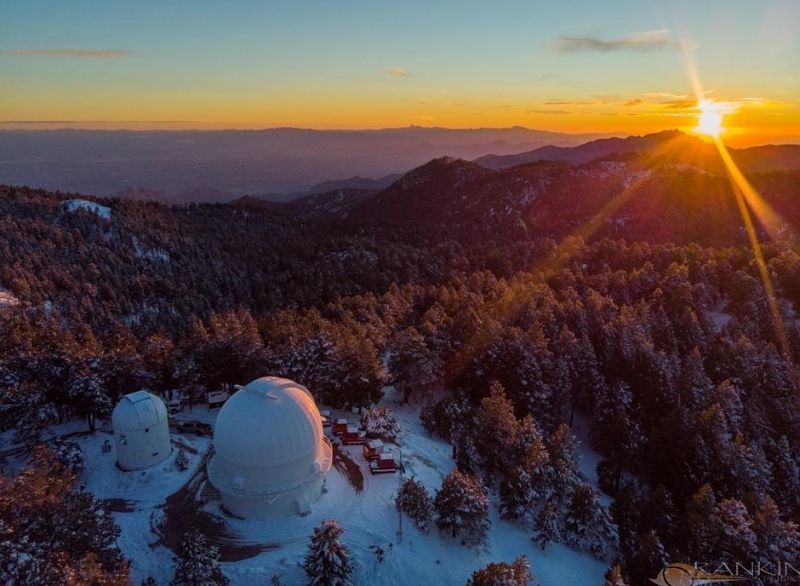Mr. Impact King and planetary defender against dangerous asteroids.
The cosmos is within us. We are made of star-stuff. We are a way for the universe to know itself.
Carl Sagan
He worked for passenger airlines for more than 20 years, when he found out he needed a change. He opted for astronomy, which fascinated him from his childhood. He started observing asteroids after being inspired by a magazine article. First from his own observatory, eight years later as a member of the best team of astronomers searching for dangerous asteroids. The only person on Earth who owns a tiny piece of rock, from celestial body he discovered himself. A legend among discoverers, Mr. Impact King, Richard A. Kowalski.
When did you get interested in astronomy and what did it start?
I became interested in astronomy at a young age. Like many in the late 60's our household was enamored by the Moon landings. My father had a large map of the Moon that he put up whenever a mission launched, and we left it up until they landed back on Earth. Watching the astronauts on the Moon and then going outside and looking at the Moon and understanding that they were there at that moment was amazing! As you can imagine, this left a big impression on me. In 1971 Mars made a close approach to the Earth and one evening my father pointed out Mars in the night sky. It was bright and really red. It dawned on me at that moment that like the Moon Mars was an actual place and that one day soon, people would be walking on the surface there too. At the time we all thought it would be happening within a just few years.
What did you want to be as a teenager?
I had many interests as a teenager, but I was never really focused on one thing, and often I was quite bored in school. I considered being an astronomer, but as I learned more about what was involved in becoming one, I realized my grades were probably not good enough to enter such a competitive field.
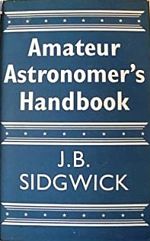
What was your favourite astronomy book in the beginnings?
The Amateur Astronomer's Handbook by J. B. Sidgwick, 1955, was a never-ending source of inspiration and dreams when I discovered it in my town library. So much information about telescopes and instruments that I kept borrowing it. I'd say my all-time favourite book of astronomy is Leslie C. Peltier's Starlight Nights, The Adventures of a Star-Gazer. I've read it numerous times, and highly recommend it to anyone with even a passing interest in astronomy.
You went to work in the field of aviation after high school. Why?
I looked into a number of possible careers when I was a teen. I had a newfound passion for photography and considered that. I wanted to fly fighters in the US Navy, but my eyesight was not good enough for that. I then tested and almost signed up to become a nuclear powerplant operator for the Navy too, but the longer commitment for that position worried my young self. Working for a passenger airline is something I sort of fell into because I had other siblings who were working for airlines at that time. I figured it was a path to get me into aviation and eventually to become a commercial pilot.
You were working in aviation for 2 decades. What was the reason that you quit?
More than 21 years to be more precise. I started working for an airline when the pay and benefits for airline workers in the United States were still pretty good. As time went on that became less and less so. Of course, the attacks on 11 September 2001 changed the airline industry forever, and after that times became very tough. I had finally stopped putting off my flight training in 2000. I had started it back in the 1980's but that did not last as a series of setbacks, financial restrictions and a very discouraging flight instructor and flight school put me off the idea. I enthusiastically jumped back into my training and by the beginning of September 2001 I had earned my Commercial Pilot certificate and was just about finished with my training to become a Certified Flight Instructor. At that time there was an extreme shortage of pilots. Just a week later everything changed. I hung on for a few more years, but eventually I realized I needed to do something different.
A major change in your career came in 2005, when you joined the Catalina Sky Survey (CSS). When did it occur to you to make a living from astronomy?
Once I started making contacts with professionals in the field I started applying for positions. Unfortunately for me there were usually better qualified candidates applying for these positions. Of course, a career in astronomy was an early desire for me, as I mentioned earlier.
Were there any astronomers that you admired?
I mentioned earlier that my interest in astronomy started very early, and I was deeply influenced by the Moon landings. A large part of that period was all of the planetary exploration that were occurring at the time too. I remember reading about Kitt Peak, the Jet Propulsion Laboratory, and more importantly, the Lunar & Planetary Laboratory. A number of names kept popping up in the sources I was reading like Sky & Telescope magazine. As a young teen I thought 'Oh, to be in Tucson at LPL!'. One of those names I remember from those early years is Steve Larson. Steve was the founder of the Catalina Sky Survey, so not only did I make it to Tucson, but I work at the institution I had hoped I would as a boy, working in planetary science, at a program founded by one of the people I used to read about!
In 1997, two interrelated events took place. You set up your own observatory and created the Minor Planet Mailing List (MPML). How did the idea for the mailing list come about and what was its goal?
At the time I had read an article by Dennis diCicco in the long defunct magazine CCD Astronomy. The title and subject of the article was how to discover asteroids from your backyard. I had recently gotten a new telescpe and my first CCD camera and was looking for something in planetary science where I could be useful. This seemed like an exciting prospect. I thought it would be useful if I could find other amateurs and maybe one or two professionals who were already observing and researching asteroids that I could ask questions and seek advice for my own program. I created MPML mostly for selfish reasons. I wrote Brian Marsden, the Director of the Minor Planet Center (MPC) at that time, and let him know I had started up a simple mailing list and asked him to let others who might be interested in joining the list know about its existence. Much to my surprise an announcement about it was published soon after that in an editorial MPEC, or Minor Planet Electronic Circular. Within a very short time the list grew to include many of the well know names in asteroid research, both amateur and professional, and became the de facto source of communication within the community at large! This was not my intention, though to say I am pleased at how things turned out is a bit of an understatement!
The mentioned article by Dennis diCicco therefore suggested you an observation program. From the summer of 1997, you began observing asteroids from your own Quail Hollow Observatory in Florida, where you have lived that time. How much time passed from idea of having your own observatory to the first light of a telescope?
Literally decades. Nothing motivates a person to do anything better than easy access. Having a backyard observatory was something I wanted since I was a boy. It took a long time before everything fell into place.
The MPML is still vital and important communication channel for asteroid observers and researchers, amateurs and professionals as well. How many subscribers does it have nowadays?
As I write this there are 1711 subscribers and an unknown number who read the list's postings via the website.
A workshop, now known as the Minor Planet Amateur-Professional Workshop (MPAPW), took place in 1999. Do you remember who came up with the idea?
Not offhand. I seem to remember that the general idea of having such a workshop was floated on the list, but I couldn't point to a specific individual who first had the idea.
The organizing committee of the workshop consisted of three professional astronomers from JPL and Lowell Observatory, and you and Paul Comba were there from the amateurs. And you were both awarded before the workshop itself, by naming asteroids after you ...
Ted Bowell of the Lowell Observatory suggested such an honor for both of us. Ted kindly hosted the MPAPW to the observatory and contributed to its success. I was the scientific chairman of the seminar and Paul was the editor of the proceedings. It was quite a surprise to get such an honor, and I appreciate it.
What was the biggest outcome of this workshop?
While the workshop motivated the amateur community, I think the biggest change was in the professional community. Having the workshop hosted by Lowell Observatory gave the event a more serious weight. Many professional researchers came away from the event with a better understanding about just how serious and capable the amateur asteroid community was, and a lot more collaborations came about because of it.
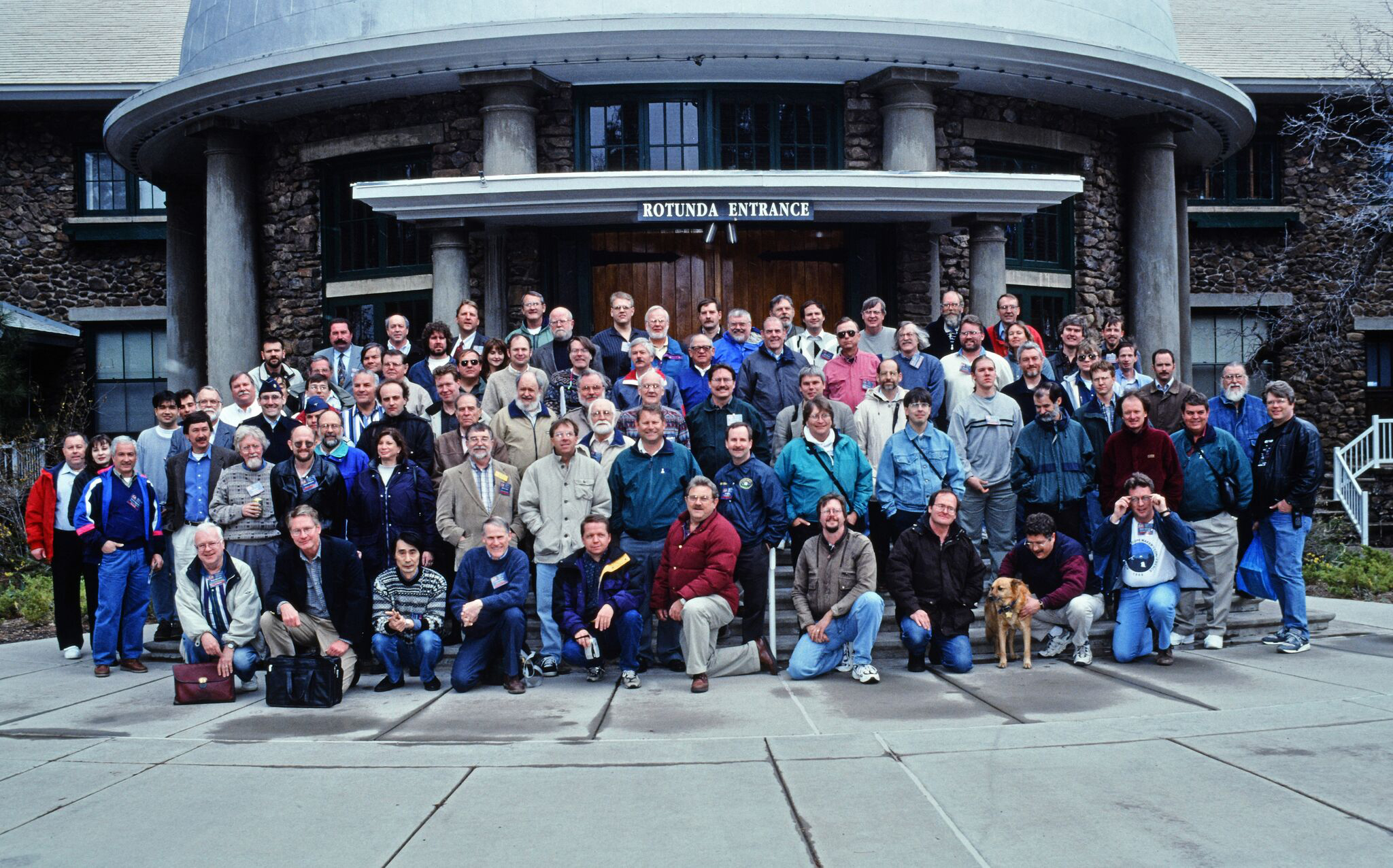
From left to right:
5st standing row: x, H. Pack, W. Ryan, J. Briggs, E. Ryan, x, x, x, x, x, x, x, x, x, x, x, x, x, B. Koehn,
4st standing row: S. Chesley, x, x, x, x, x, x, x, B. Skiff, A. Henden, x, x, x, x, x, x, x, x, F. Shelly, J. Medkeff,
3st standing row: J. Hoot, x, P. Pravec, B. Denny, K. Ziegler, x, B. Owen, B. Skiff, x, x, W. Cooney, I. Girffin, x, x, x, x, x, x, x,
2st standing row: x, x, B. Warner, x, x, J. Skvarč, x, A. Harris, x, x, x, x, x, x, x, x, x, x, x, x,
1st standing row: D. Dixon, x, x, S. Larson, T. Bowell, x, G. Malcom, J. Stevens, G. Lucas, P. Comba, J. Rodgers, B. Dillon, Ch. Bayus, x, x, x, G. Garradd, L. Robinson, x,
bottom row: B. Marsden, D. Yeomans, S. Nakano, x, B. Sikes, J. McGaha, R. Kowalski, R. Tucker, P. Weissman, W. Johnson
There were other workshops in 2000, 2001 and 2003. Did it stop then?
There were several smaller workshops in Europe and I think in Australia during that time too. After the events of September 11, the enthusiasm for the meetings waned a bit. There have been a few small discussions on having another, but to date nothing has come from them. That may change, or we might consider having a virtual workshop in the future. We shall see.
An asteroid (7392) was named after you in April 1999, and two years later you named asteroid (14627) as Emilkowalski. Which name pleased you more?
(14627) Emilkowalski, naturally. It's the only asteroid I've discovered as an amateur. I felt that naming him after my father was the right thing I could do, since it was he who led me to astronomy. Since then, I've discovered hundreds of near-Earth asteroids and literally thousands of main belt asteroids, but none is as extraordinary as the one.
Since 1999, you were applying for position at astronomical institutions. As you said, there was always a better qualified candidate. Finally, you succeeded in a case where you didn't even want to apply originally. What happened to the Quail Hollow Observatory when you got a job at CSS?
The house and property were sold at the time. The observatory had a retractable roof, and to the east, south, and west, the walls could be tilted. It looked different and worked like a garden hut, so I guess the new owners are using it this way.
Do you remember on your first day at CSS?
The first day was a little daunting. Not being very familiar with the University of Arizona campus, or the city itself, hoping to make a good impression on the team, getting used to the pace of my new employers and position. Moving from the private sector to academia... I remember it all very well.
How does your observation night look like? Is it different from 15 years ago?
In 2005 our 1.5-m (60-inch) telescope at the peak of Mount Lemmon had just been refurbished and put back into service. Catalina was looking for an additional observer at that time. I was lucky enough to be awarded the position as I had many of the qualifications the team required to operate the telescope. Back then our software was a lot less sophisticated, and surveying required a much more hands on approach. Today our software, almost all of it written by our own engineers, is much more sophisticated and vastly more capable than what we were using 15 years ago. Back then we were using 4k x 4k CCD cameras, while today we have upgraded both of our survey telescopes, the 1.5-m on Mount Lemmon, and the 0.68-m Schmidt telescope on nearby Mount Bigelow with 10k x 10k cameras.
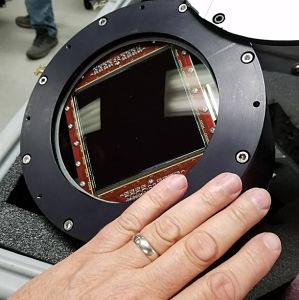
These 111-megapixel cameras cover 5.0 and 19.4 square degrees respectively. On a given night we can cover 1000 square degrees of sky with the 1.5-m & a whopping 4000 square degrees with the Schmidt. Our standard survey exposure is 30 seconds, and we can nominally reach down to 21.5V and 19.5V with these telescopes. On the most transparent nights with subarcsecond seeing, the 1.5-m regularly finds asteroids at 22.1V! We also have a dedicated follow up telescope with a 1.0-m aperture, located next to the 1.5-m on Mount Lemmon, and we have regular access to the 1.54-m (61-inch) Kuiper Telescope located at the Mount Bigelow site. We are now starting to use the 2.3-m (90-inch) Bok Telescope on Kitt Peak too.
Now that background has been covered, I'll explain a bit about what a night of surveying is like.
After the telescope dome and mirror covers have been opened, the observer gets all of the software needed for the night's run going. The asteroid orbit database is automatically downloaded from the MPC, and the observer confirms that all of the hardware and software is functioning properly. Then the telescope is focused, and the pointing initialized on the sky. Most of what we use is custom written by our own software engineers, though we do use a few freely available tools such as DS9 to view our images. The major pieces of our suite are Control which oversees the entire observing operation, from talking to and gathering the images from the camera, to processing the images, calibration, astrometry, moving object detection, etc., and allows us to validate these detections and submit the observations of new discoveries to the Minor Planet Center. Queue Manager, which determines when a set of observations is to be made, Queue Viewer, which provides a way for the observer to keep watch over the progress of the queue and interact with the queue when appropriate, adding, delaying or removing planned observations, Telescope Control System, which is actually a GUI with the computer providing the telescope control, and Coverage Tool, which is a graphic display of the sky which shows our standard survey fields, user created fields for objects of special interest, the current telescope position and if the observer chooses where our other telescopes are pointing too.
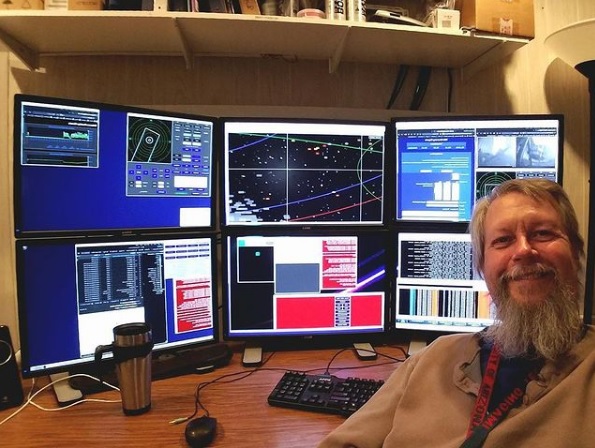
Once it is dark enough the telescope is focused, the pointing initialized and the queue is then started automatically when the sky is dark enough to do so.
The typical survey pattern is 12 of our standard fields are combined into a set. The telescope images each field in the set using a 30 second exposure. Once all of the fields have been imaged the cycle repeats until each of the fields have been imaged 4 times. This takes about 30 minutes when slew time and image downloads are taken into account. Control then processes the images as outlined above and each field is presented to the observer for validation. While the observer validates the images from the previous set, the telescope continues to take data on the next set of fields. This continues all night long.
On average the telescope observes 20 of these sets of fields each night, give or take a set or two depending on the time of year. Most of the fields do not contain any new Near-Earth Object candidates, so we mark all of the detections with a no, not real, and move on to the next field. Every so often we come across an object that cannot be identified by our internal database, or the databases at the Minor Planet Center and the Jet Propulsion Lab. If the object passes these checks the observations are submitted to the MPC via email. Once the MPC receives the observations, they too automatically check to see if the object is known. If it appears to be a new NEO, then the discover observations, and an ephemerides for the object covering the next 24 hours is added to the public Near Earth Object Confirmation Page (NEOCP) so other observers, professional and amateur alike, may target the new discovery and obtain additional observations for it. This entire process from validation to public publication on the NEOCP typically takes less than 10 minutes!
This process of monitoring the telescope systems, the weather, coordinating observations with our other observers, and more continues throughout the night until the morning dawn renders the sky too bright to continue. At the end of the night, all of the observations of known objects which were observed during the night are submitted to the MPC so their orbits may be updated with the latest observed positions. The telescope is returned to the stowed position and the mirror covers and dome slit are closed for the day. Our data is automatically archived and transmitted via a radio link to our archive units in our offices at the Lunar and Planetary Lab.
„Comet Skunk“ is the official mascot of CSS. Can you share the story about it with us?
Early one evening in February 2009 I was surveying with our Schmidt telescope on Mount Bigelow when I heard a noise behind me. We sometimes get field mice in the building and I thought it was just one of those encounters. If we can't get them out of the building, they often end up dying, either because they can't find food and drink, or find one of the traps set up for them. As I continued to survey, I kept hearing the sounds but when I turned around, I saw nothing. This continued and eventually I spotted the creature, and it certainly was not a mouse! Realizing I was in a small room with a skunk I exited the dome rapidly and headed to the protection of my car!
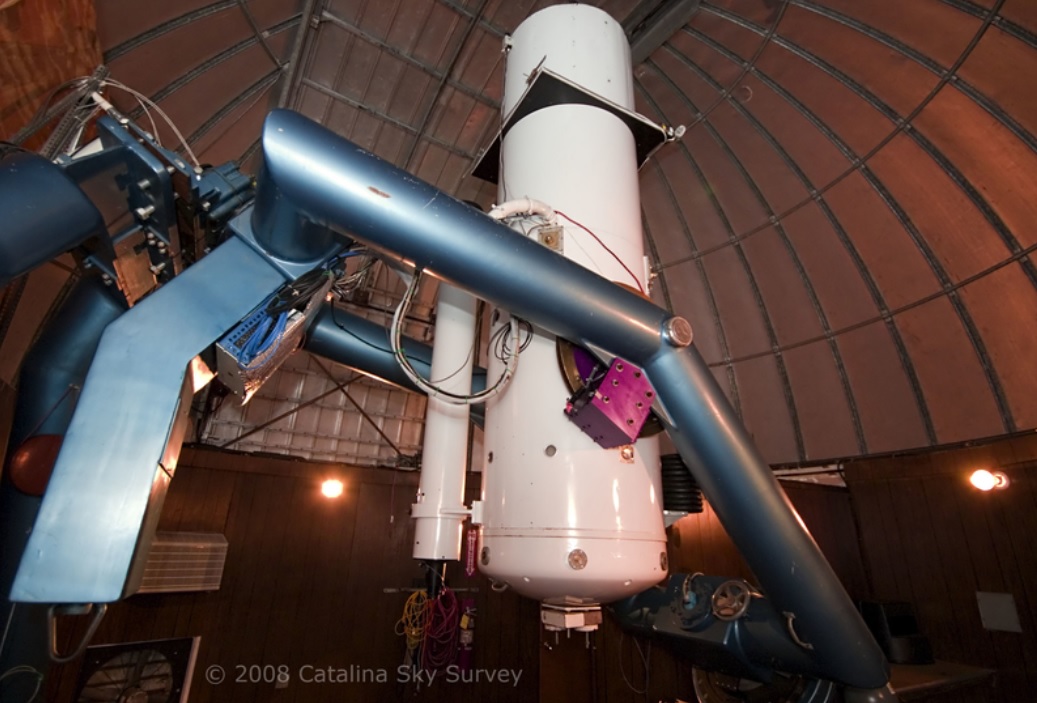
It was already a cold night and the skies were expected to cloud over after midnight due to an approaching storm. I tried calling my PI and the observer at the 1.5-m telescope, but neither was immediately available. Even if they were, there was not much either of them could do for me. I then decided to call my own wife, who used to work as an animal behaviourist at the San Diego Zoo. After she stopped laughing, she advised me to leave a trail of snack food out the door in an attempt to entice the skunk to leave. I observed the skunk eating the snacks until it got to the doorway, when it ran back inside. It apparently decided that a warm comfortable building, where it was being provided food, was a much better option than being outside as a storm approached!
I eventually made it back inside and secured the telescope, closing the dome and getting everything safe for the approaching storm. Out Mountain Operations crew was alerted and the next day they set out a live trap in the warm room, but the skunk was not captured until the second day. It was released a number of kilometers away from the site. We lost almost two nights of surveying due to this encounter but luckily the skunk did not spray inside the building! Following the event, our principal engineer Alex Gibbs wrote in an email 'Comet Skunk – White fuzzy tail, kinda looks like a dirty snowball, has occasional outgassing when it gets heated, causes panic if it gets too close.' It was adopted as our team mascot.
You are known as an "Impact King", because you are the only person to discover 3 impactors, 2008 TC3, 2014 AA and 2018 LA. Do you know who called you that?
My wife gets the blame for that name. She came up with it. I'll leave it right there.

On October 6, 2008, you discovered an object that was going to collide with Earth in less than 24 hours. Today we refer to this as the impactor 2008 TC3. How do you remember those moments?
That night was like any other at the telescope. 2008 TC3 looked like any other NEO candidate presented for validation. There was nothing out of the ordinary to make it stand out. I submitted the observations to the MPC, and later that night, another set of follow up observations. This was before we had our 1-m follow up telescope, so we made follow up observations with the 1.5-m too.
The next afternoon I woke up and headed up to the telescope dome from the dorm to have breakfast and read my emails. Our Co-PI, Steve Larson was on-site consulting with the site manager the late Bob Petersen planning on the location of the 1-m telescope. Steve congratulated me on discovering an earth impactor the night before and added that it was going to impact that evening. I thought he was joking. Since it had never happened before, and our alerting system was much less robust than it is today, I had a hard time believing that something I picked up the night before was going to hit. I started up my laptop and checked my emails and was stunned to see a few hundred emails discussing this object and the scramble to obtain additional observations before impact. When you get right down to it, I was literally the last person in the community to know I had discovered the first known Earth impactor!

Two months later, in December 2008, an expedition led by Peter Jenniskens found about 4 kg of debris from that fall. A year passed since then and you became the owner of two-gram fragment from a body that you discovered yourself. Was it your best Christmas present ever?
It certainly was. Meteorites are named for the town or geological landmark near by the fall. The closest landmark in the Sudan is Almahata Sitta, or (Railroad) Station Six in Arabic. Almahata Sitta is a groundbreaking meteorite fall. So much interesting science has been accomplished from this discovery. In fact, another paper was recently published about this asteroid and the parent body. I suspect it will continue to be studied and fresh understanding of the asteroids and our solar system will come from it for many years or decades to come.
What did you feel holding that little piece of rock in your hand?
It certainly holds a special place for me. Without a doubt it is one of the greatest honors of my life. After I received my specimen, my friend Roy Tucker remarked that not only am I the first person in history to have discovered an asteroid before it impacted with the Earth, but I am the first person in history to own a piece of an astronomical object that I discovered! I can think of anything more special than that!
On New Year Eve 2014 you found the second impactor 2014 AA and you were the only one who observed it. According to calculations, the collision with Earth's atmosphere occurred over the Atlantic, and if the body survived the fall, its fragments are at the bottom of the ocean. The third impactor, 2018 LA, appeared in June 2018 and 8 hours have passed since your observation and a bright bolide shone over Botswana. Peter Jenniskens again found pieces of a meteorite. When you found out, didn't you want to have a piece of that too?
Of course, I would, but knowing that I once again have continued to the body of human knowledge is actually more important to me. I suspect that 2018 LA will be similar to Almahata Sitta and will be studied for years and decades to come.
You are not only a discoverer of many NEOs, but also 14 comets. Is any of them special to you? Do you remember your first one? Does the view of a new object still excite you?
Being a comet hunter and discoverer is another great honor that my position affords me. You may have noticed that the other active professional surveys have all of their comet discoveries named for the program, and not the individual who made the initial observations. CSS is different in that aspect. Our founder, Steve Larson, is in fact a comet researcher. When he started CSS he felt that the observers where the ones doing the hard work, and were the people who noticed that the new discoveries were active bodies, comets. He felt that for this effort we should get the long-held distinction of having the comet named for us. While there are comets named Lemmon and Catalina, these typically only happen when we did not detect any activity when we discover the object and submit it as a new asteroid. Only later are these objects determined to be comets. My first comet, P/2005 W3 (Kowalski) was discovered the night of November 25th, 2005, less than 3 months after I joined the CSS team. That excitement has never worn off. As a team, we all are in friendly competition with the other surveys to find not only near-earth asteroids, but comets as well. We're also in a friendly competition with each other on our own team. It is unlikely that any of us active today will rival our former teammate Rob McNaught who is the greatest comet discoverer of all time and will likely remain in that top position. He currently has 82 comets named for him!
For many years Catalina Sky Survey has been and still is the leader in the number of NEO discoveries. What is the secret of CSS?
The people, without a doubt. We have the best team. Over the past two decades, CSS has discovered nearly one half of all known NEOs. That didn't happen by accident. The CSS crew are all driven to be the best, not only just to occupy that spot, but because we all known how serious this work is. When you come right down to it, literally everyone on the planet depends on our small group, and the members of the other NEO surveys, to do our jobs and to do them well. That isn't an empty brag, it is the truth. We may not dwell on that point, but it is what drives us all. Everyone on our team contributes to that goal. Not just the observers but everyone. That includes our support staff on campus as well as the Mountain Operations crew from Steward Observatory who keep the telescopes and facilities running. Each and every set of observations that gets submitted show the observer on duty as the observer, but the names of everyone on the team is included in that submission too.
At CSS we don't necessarily have the best telescopes for this task. We certainly have a less than ideal location being located so close to the city of Tucson, so it has to be something else. A major contributor to the effort is that we have observers on site, each night, all night, every night, and our observers look at and validate each potential candidate. The observer can decide to change up the observing strategy depending on the weather or other conditions that would affect the observations. Having a human in the loop in real time lets us take advantage of even poorer conditions, and the human eye & brain is still better at pattern recognition than any computer software today. That allows us to work at a much lower signal to noise ratio than any other program.
Lastly, we strive to find an implement and exploit every improvement we can. 2020, with all of its difficulties, was another record-breaking year of Catalina.
What gives you the most satisfaction in the work you are doing?
Being able to contribute to science, our understanding of the solar system, and being able to provide protection to everyone on the planet. Being part of the best team ever assembled to do those things and continuing to do them well provides great satisfaction to me at a very deep level.
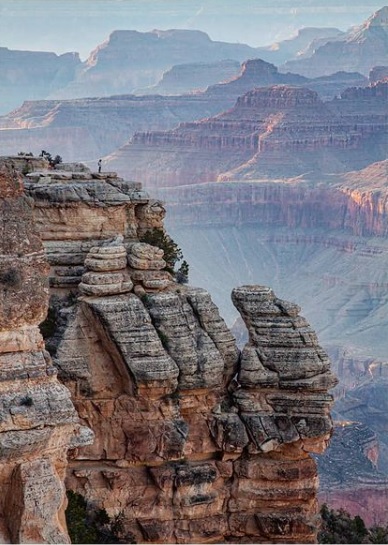
Czech astronomer Petr Horalek uses expression "7 pearls of astronomy" for most spectacular astronomical events he wishes to experience. What would be your 7 pearls?
Hmmm. I've had many astronomical experiences already. Total solar eclipses are spectacular. Everyone should experience at least one in their lifetimes. Seeing the aurora too. I have yet to see a large active display like curtains, but one of the most memorable times I have watched them was from Tampa, Florida, when the entire sky was pink! There was no structure or apparent motion, but to see them that far south was amazing! I saw McNaught's Great Comet, C/2006 P1, in the day time from the Mount Lemmon Observatory! Seeing the tail of Comet Hyakutake C/1996 B2 spreading nearly 90 degrees across a dark sky! That's four. After that the experiences start becoming a multitude. They memories of many astronomical events, from viewing galaxies hundreds of millions of lightyears away using backyard telescopes to viewing Mercury using the 90 inch Bok telescope on Kitt Peak, watching deep red lunar eclipses, to simly sitting back and watching impressive meteor showers for hours on end with nothing more than my naked eye. Listing just 7 is too limiting when it comes to astronomy!
What´s your favourite astronomy related quote?
“The cosmos is within us. We are made of star-stuff. We are a way for the universe to know itself.”
Carl Sagan
You are passionate about trains and I doubt that Ringo Starr´s voice as Thomas the Tank Engine is the reason. So how this passion started?
No. We didn't have Thomas when I was growing up. My father commuted by rail each day to his workplace in Manhattan. When I was young each evening my mother would take me with her to pick him up at the train station, so from the very beginning of my life, railroads and one train in particular, were extremely important to me, and quite impactful. As I grew older the desire to learn more about the local railroad, brought me in contact with history and sparked a deep interest in that subject as well.
Besides trains, you are passionate about photography and you shoot with film that is decades old. What makes old film so special? Is that nowadays the best relax for you?
I returned to shooting film after a nearly 20-year hiatus. I began my photographic efforts as a young teenager. I began shooting digital images around the year 2000, and I still do use digital cameras when appropriate. However, in 2018, I came across some unexposed rolls of film I had stashed away in my freezer and thought I should get them out of there and finish off my analog efforts once and for all.
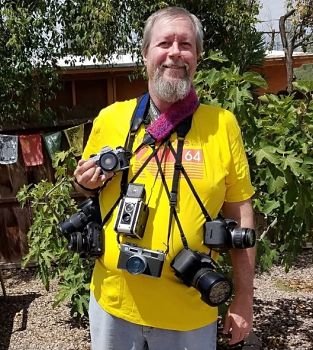
That was a bit of a mistake as I realized how rusty I had become as a photographer.
Digital is great, but it makes you lazy. Because of the time, effort and thought involved to make an analog image I could see my images improving in quality once I started shooting film again. The way I look at it today, some artists use watercolors, other use oil-based paint. Neither is better or worse. The artist chooses the medium they find is the best for expressing their art. I've found film is my best medium for a number of reasons. As for using old, expired films, they're fun. The results may not be as good as fresh films can produce, but it gives me the chance to shoot film stocks I could never afford when I was younger, or next had access to. In the past I would turn up my nose at film that was nearing its expiration date. Now I have no problem shooting film that is as old as I am, and still get amazingly good results with it! The oldest film I ever shot expired in April 1944! Looking at the images you would never know it wasn't brand new.
At the workshop in 1999, you emphasized the importance of amateur astronomers in observing asteroids. What will the research look like in the near future when the next big telescopes and surveys start working?
In 1999 a number of the professionals attending MPAPW were surprised at the advanced level that amateurs could and were performing at. In the two decades that followed it is no longer surprising. In fact, amateurs contribute to a number of difference fields of research in astronomy, and asteroids are no different. As the new larger surveys come online there will be many objects that will be simply too faint for amateurs to track. We already have that problem today with Pan-STARRS and our own discoveries reaching to 21.5V and fainter. However, there will be as many or more objects discovered close to the Earth that will need physical study. Amateurs are well positioned due to their nearly unlimited telescope time to obtain light curves of newly discovered objects, which will provide rotational periods, and even shape models for these objects. Multicolor photometry will help determine the physical make up of these bodies.
A decade ago, there was some who lamented the end of amateur asteroid research. Ten years on and I can't remember the last time I heard anyone making such an assertion. New professional projects almost always open up new avenues of research for the amateur. New technologies become available to the amateur all of the time and become less expensive every year. Who knows what we'll see the amateur community doing in ten or twenty years? All I can say is never count the amateurs out!
